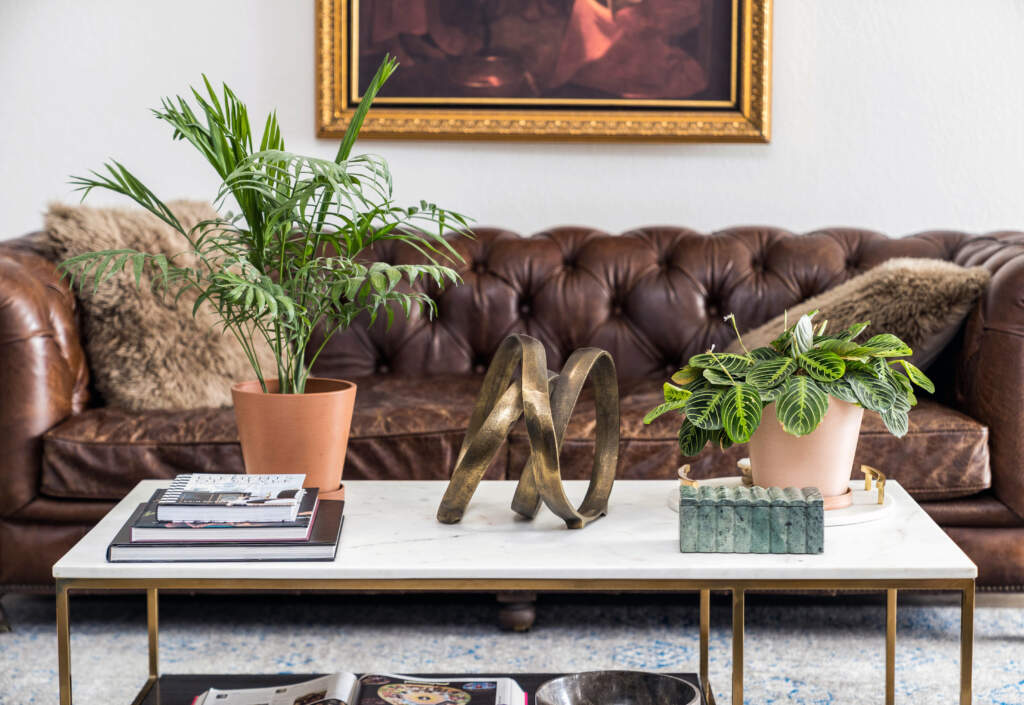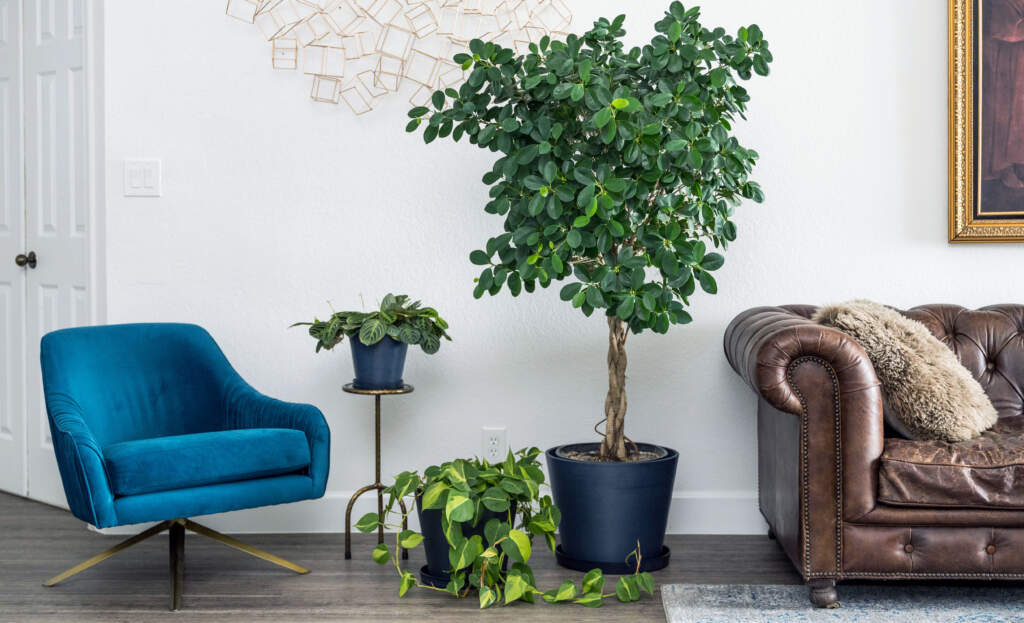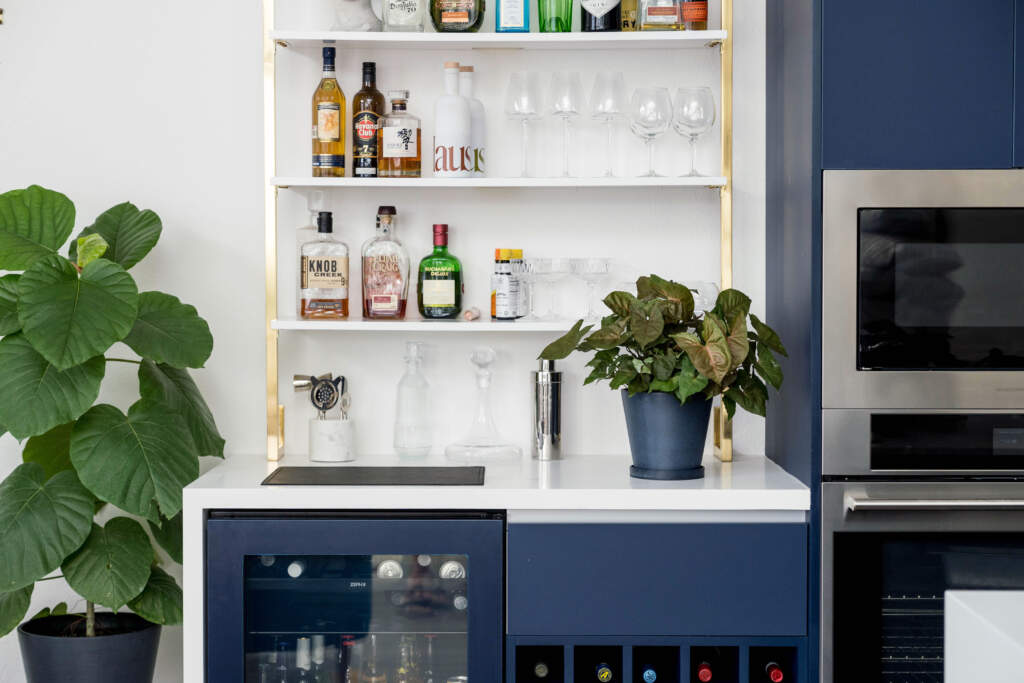
Today’s fastest-growing trend is bringing the outdoors inside. You can see examples of this everywhere. Many new homes include huge picture windows with spectacular views. There is an absolute craze to add houseplants as decorations in interior design. Why are we so attracted to nature inside our homes?
Why We Love Natural Design
Studies have shown that exposure to more plants and greenery can benefit homes, work, and community spaces in many ways. They can improve not just your mood but your overall mental health. Plants have been shown to reduce stress.
Many offices are decorated with plants because they can increase productivity and enhance and nurture the natural sense of creativity. Growing plants in nearby spaces can help support a strong immune system. While all plants will improve the air quality around you, some plants work extra hard as air purifiers.
Historically, by nature, humans spend a lot of time outdoors. However, modern culture, work schedules, and lifestyles keep people indoors more than ever. This has helped to drive the need for more natural design.
What Is a Biophilic Design Concept?
Another word for natural design is biophilic design. Biophilic design in architectural design or interior design incorporates elements from nature.
There are six principles of biophilic design:
Environmental Features
These are the universally recognized elements of the natural world like colors, animals, plants, and sunlight. This would also include things like using natural materials and having natural views and textures in interior design.
Natural Shapes and Forms
Much of today’s design is in the form of straight lines and precise edges. However, natural shapes and forms are organic and may not always be uniform. Including curves in design is an important aspect of a more nature-driven design.
Natural Patterns and Processes
The human senses are drawn to variations in patterns, shapes, and colors. Nature includes a vast grand array of design that ranges from the most simple to incomprehensibly complex.
Light and Space
Natural lighting is usually thought of as sunlight, but it can be so much more. Light can be direct or indirect. The brightness of natural light varies throughout the day, and shadows change as the sun moves across the sky. Consider catching morning or evening sun and how this affects your space.
Click here to read more about the science of light and how it pertains to your houseplants.
Place-Based Relationships
Biophilic design considers which kinds of plants are native to the local region and climate. Importance is given to the cultural, religious, and historical meaning of a plant as well.
Evolved Human-Nature Relationships
Biophilic design emphasizes the aspects of nature that have driven human evolution as opposed to simple observations of nature.

What Are Biophilic Elements?
Biophilic elements are the elements that connect you with nature. There are many ways to introduce biophilic elements into your interior design or office decor.
Here are some of these elements and ways to introduce them into your interior design or office decor:
Animals
Animals don’t need to be limited to having a large pet at home like a dog or a cat. You can opt for a bird or an aquarium. Terrariums can make a great addition too. If you aren’t sure about bringing a new animal friend into your home, consider a view of the tree in your yard and the birds or squirrels that play there.
You can always add a birdbath or a bird feeder to encourage new animal life to come closer to your window.
Click here to see our selection of animal-friendly plants.
Plants
Using plants in interior decor is easy and doesn’t require near the upkeep of adding an animal to your home. There is also a myriad of ways to add plants to your space. From a single potted plant in a window to a conversation piece designed around a plant, the options are really endless.
Click here for our guide for new plant parents.
Water
Adding water to your space can add movement and bring a refreshing touch. Water is symbolic in many cultures and can add a spiritual element to your space. A small water feature like a miniature waterfall or tabletop display can be magical.
Natural Lighting
Natural lighting is a part of natural living. You can actually get sick if you don’t get enough sunlight. It produces vitamin D in the body and helps contribute to core metabolic processes. From a sunroof to an open window to an outdoor workspace, try to find a way to fit more natural lighting into your day.
Fresh Air
Any confined space, like an office or even a single room in a home, can feel stuffy from a lack of airflow. Not only do we benefit from fresh air, but also air movement. In addition, the cleanliness and quality of the air that you breathe really does matter.
Why Choose Plants as a Main Biophilic Element?
There are small everyday ways to bring nature to your indoor space. Open your curtains or shades to increase your exposure to sunlight. Open the windows of your home or office for some fresh air and to feel the occasional breeze. Plants bring something more. They are alive, and they serve a purpose beyond making a statement in your decor.

How to Use Plants in Your Biophilic Design
Beautiful, affordable, and easy to care for, plants are the obvious choice when you want to add more biophilic elements to your interior design. It’s easy to add a plant here or there to your home decor.
However, you should consider which plants will do best in specific rooms. Consider how much and what kind of light is available. Think about the temperature and humidity of the rooms as well. You might even want to consider which rooms are more often frequented by children and pets.
Here are a few tips to enhance your natural living and biophilic design by adding houseplant decorations.
Start with a Few Plants
When you first discover a love of plants, it can be easy to go overboard. Buy a plant or two. Do your research and make sure the plants you start with are easy to care for and well-suited to the environment that you’ll be putting them in.
Doing too much too quickly might mean you won’t be able to beat the learning curve and keep up with your plants. Slow and steady will bring you the most success when growing plants.
The PlantVine Beginner Plant Box is a great way to get started. Click here to learn more.
Shop Reputable Growers
If you want to grow healthy plants, you need to start with healthy plants. This means opting for reputable growers and nurseries. PlantVine works with independent specialty growers and hand picks vibrant and healthy plants that are shipped with care to your front door.
Check out PlantVine’s industry-best guarantee here.
Choose Plants that Match Your Style
Interior design is full of personal choices, and your plants should be no different. Pick plants that go with your decor. Let your plants do as much to speak for your style as your choice of furniture, colors, and art do.
Choosing plants that match your style will give each room, as well as your home overall, a more cohesive look.
Put Plants in Your Bathroom
You might consider your tile and countertops, but many people neglect to decorate the bathroom, especially when it comes to plants. There are many varieties of plants that live quite happily in the bathroom. or example, consider an orchid or lily or another type of flower that does well in high humidity.
Bring a Corner to Life with a Larger Plant
Not all plants need direct sunlight for healthy growth. Instead, choose a plant that likes indirect or low levels of light to enhance a drab corner in your home. Small trees and plants with lots of foliage are a great option for areas like this.
Click here to shop our selection of large indoor trees and plants.
Use a Variety of Sizes and Shapes
Using a variety of sizes and shapes of plants creates contrast and is more visually interesting than using a whole line of the same type of plant. Opt for different shapes and colors among the foliage and flowers as well for an even more exciting visual display.
Choose a Statement Piece
Just like clothing or jewelry, when it comes to interior design, your home should have a statement piece. What better statement piece than a large tree or bold glossy foliage that fans out to catch the eye?
Choose a large plant or tree that you like, and that will catch the eye. This is the kind of plant that will have all of your guests talking when they enter your home.
Add Flowers and Foliage for Color
A terrific way to add a pop of color is by adding a plant that flowers or has colorful foliage. You can use colors that are part of your existing color scheme, or you can use flowers as a way of bringing in a contrasting color for variety. Consider using multiple colors of flowers and foliage for a real show.
Planters and Pots Matter Too
Part of your home decor is the planters and pots you choose for your plants. You can choose planters that are barely visible or ones that are as ornamental and elaborate as the plants themselves. In some cases, you can even get furniture, such as tables and shelves, with planters already built into them.
Click here to our selection of planters and pots, including our line of stylish, eco-friendly premium pots.
Do What Works for You
If there is a certain plant that you like, go for it. Remember, there are no steadfast rules of plant design. Do what you like as long as your plants get the nutrients they need to grow and stay healthy. Make your plant design your own.
Bring the Outdoors In with PlantVine
Growing and tending to your own plants at home is an incredibly rewarding and fulfilling experience that can add life and vibrance to your home. In addition, they’re the perfect accent for interior design, adding a biophilic accent to your home’s overall aesthetic and decor.
When you are ready to add plants to your home, shop PlantVine for all of the best plants, nurseries and services.


